However, the UK’s inflation data looks worse partly due to the timing of calculations. In the coming months the energy price hikes of 2022 will drop out of the inflation statistics and will bring the annualised figure down, making the economic picture look brighter. There are however still many structural issues to be aware of.
In Europe the headline inflation rate increased since last June while core inflation (which strips out volatile food and energy costs) decreased slightly.
Emerging markets, meanwhile, have potential tailwinds for the rest of the year. The probability of interest rate decreases are higher relative to developed markets and a weaker dollar has made the cost of servicing their debts cheaper.
There have been (and still are) difficulties in the banking sector. This issue is currently restricted to mid-sized banks mostly in the US but if investors and deposit holders have a confidence crisis then this has the potential to spread.
The problem with banks is twofold. Firstly, they hold huge portfolios of government bonds to meet their regulatory requirements for capital. These bonds have lost a lot of value over the last year as interest rates have risen.
Secondly, deposit holders can withdraw money and move their capital to another bank within seconds via online and mobile banking, meaning a “bank run” no longer involves long queues outside the doors and can happen much more quickly.
When deposit holders withdraw money, banks need to sell capital to meet redemptions. If this capital is held in government bonds which have lost value, then these losses are realised.
The scale of deposit holders withdrawing money from troubled banks is in the billions, and so it becomes clearer as to why some banks have failed. It is this mismatch in the maturity of banks deposits and investments, when their investments have lost value, which causes problems.
Currently the banking issues are not likely to pose a systematic threat. It may, in the US, restrict economic growth and pose the argument for the Federal Reserve to be more relaxed in its monetary policy by way of reducing interest rates.
In our view this is unlikely. Why? Inflation is the Fed’s primary focus and it cannot risk cutting rates if inflation if not under control.
Both UK and European equity markets rose over the past month while American markets dropped. Yields on the 2 and 10-year UK government bonds are up as well, while yields on the 2-year US treasury stayed the same, and yields on the 10-year rose slightly. The US yield curve is still inverted with the 2-year yield at 3.8% and the 10-year yield 3.4%. Recessionary risks are still present in the US, and with the troubles in the banking sector this only enhances these potential for volatility.
Areas of focus
- Emerging market equities show signs of potential. The combination of earlier rate increases and a weakening dollar provide tailwinds. Headwinds may be in the form of slowing developed market growth.
- US technology stocks have provided returns this year as earnings have beaten analysts’ forecasts, mainly driven by cost cuttings. The NASDAQ is currently up over 19% YTD.
- The FSTE 100 has continued its positive performance this year, driven by energy firms continuing to record high quarterly profits. A weakening dollar will weigh on the FTSE 100 in time to come.
- Government bonds are priced at attractive yields and shorter-duration is still preferred. This is likely to change as markets price in high probabilities of interest rate cuts.
- Japanese government bonds with short maturities are preferred as investors bet on increasing interest rates.
- European stocks continue their strong YTD performance despite headline inflation rising again.
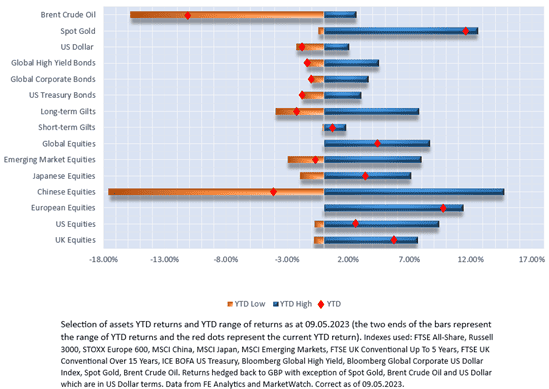
UK
Interest rates (sigh)… Yes, interest rates are again the main talking point! Interest rates, inflation and a bleak economic outlook. But read on!
Interest rates currently sit at 4.25% and inflation has sat above 10.0% since September, currently at 10.1%. Compared to the US and Europe where inflation has fallen significantly (5.0% and 7.0% respectively), the situation in the UK looks on the face of it a lot worse. This is likely why the IMF had forecast the UK to have the worst economic growth out of all major developed economies this year.
Not all is woe and despair though! The volatile elements of inflation, food and energy, show signs of waning.
Natural gas prices are falling rapidly, down over 65% from a year ago. Inflation in the UK will drop as the price rises from 2022 fall out of the data. How far this drops and where it sticks is another question.
Food price inflation has been a big driver in the inflation picture over the past few months, affecting both Europe and UK alike. These pressures are expected to partially subside over the coming months, helping to bring the UK inflation figure down. Food inflation was recorded at 19.2% in March, with supermarkets expecting this to come down in the coming months. This was reflected in the food price index which reached a peak and has since eased somewhat.
With food prices rising, consumers have been switching to cheaper supermarkets and retailers, helping to boost their revenues over the recent months. This is expected to continue, even after prices come down as consumers get used to shopping in different places.
So with both food and energy prices expected to fall, the other elements of inflation will be key as to at what level inflation sticks at.
We have talked in past commentaries about the structural issues which are likely to result in inflation sticking at levels above the Bank of England’s 2% CPI target. These being a tight labour market, decarbonisation and a reduced workforce due to early retirement.
These issues will keep core inflation (excluding volatile food and energy) elevated for longer. Investors think it will be higher than other developed countries and believe UK interest rates will therefore need to go even higher.
Consumer confidence in the UK has started to recover but is still well below that of the US and Europe (see below). Increasing confidence may be a sign that economic performance will not be as bad as previously predicted. If consumers are confident about their financial situation, we would expect retail sales and demand to increase.
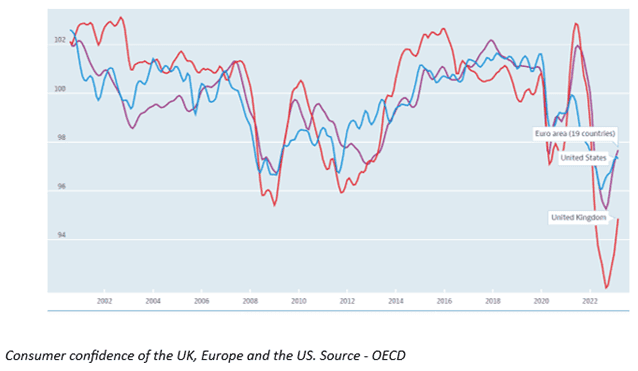
Economists believe that the labour market is starting to loosen, with wage growth showing signs of slowing. This data is not concrete and the Bank of England is not fully convinced that rate rises need to stop. Further data over the coming months will more accurately show the state of the labour market.
The expectation is for interest rates to reach 5% in 2023 and this has been reflected in bond yields. Yields on the 2-year Gilt have risen 10.88% over the last month sitting at 3.81%, with yields on the 10-year Gilt rising by 8.73%, sitting at 3.79%. Both maturities are below their YTD high but are creeping back up (Data as at 27/04/2023).
Corporate bonds have held their value to a greater extent than government bonds.
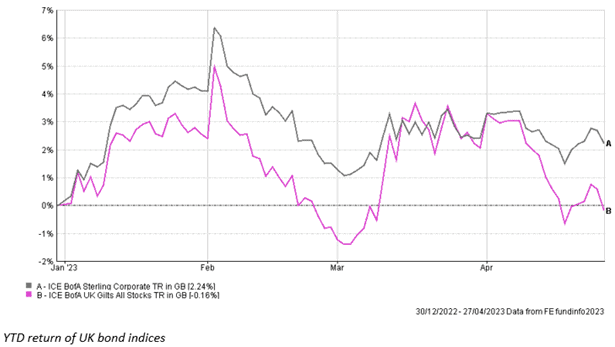
Both government and corporate bonds experienced a big uptick in March. This was due to investors moving to the safer investments amid worries over the banking sector. However, recent economic data which drove gilt yields up resulted in a bigger loss for government rather than corporate bonds.
Corporate bonds exhibit characteristics of both equities and bonds and are preferred by investors currently. They experienced a big inflow towards the end of 2022. However, with insolvencies rising individual selection is key and investors are preferring bonds further up the credit rating spectrum, i.e. higher quality debt.
Latest government figures show that government borrowing was less than previously expected, and this had opened up the idea that there may be tax cuts later in the year. Government revenues from tax receipts were also lower which shows that economic activity was not as buoyant as expected. This increases the risk of an economic slowdown.
GDP growth for the year has been positive however. The economy expanded by 0.3% in January after declining by 0.5% in December. While the Bank of England expects the UK to avoid a recession this year, the Office for Budget Responsibility expects the economy to decline by -0.2%.
Again, although in a recession we would usually expect interest rates to come down, as the Bank of England’s main target is bringing inflation down, interest rate cuts in the short term are unlikely.
In short, while volatile contributors to inflation are expected to come down, core inflation levels will likely be higher than the 2% the Bank of England is targeting and interest rates are expected to reach 5% this year.
UK equities initially started the year off well but performance dropped in March amid increases risks in the banking sector. However, since then performance has improved with all but the FTSE AIM 100 in positive territory. The banking sector has stabilised for now, and further drops are not expected.
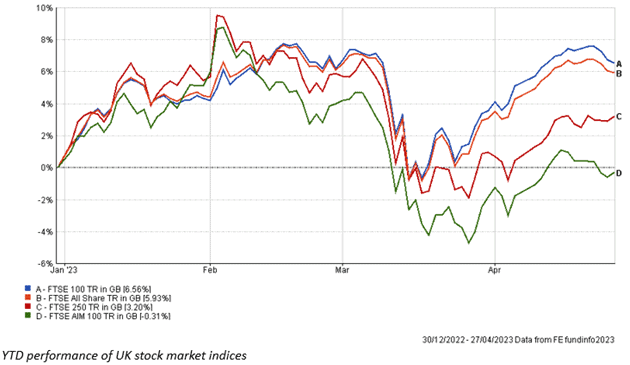
With consumer confidence ticking upwards, it is expected that UK equities will post positive returns for the rest of the year. Notably travel and leisure stocks are expected to perform well with summer on the horizon and consumers spending more of their savings.
However, equity markets are not currently pricing in a more serious economic downturn. Any poor GDP growth or data pointing to a still tight labour market will probably result in falls in equity values. We are already seeing increased insolvencies as a result of increased interest rates. Investors are still preferring quality companies with stronger balance sheets.
The UK is trying to attract technology companies to list on UK stock exchanges and to do more business there, but the recent news that the Competition and Markets Authority has blocked Microsoft’s acquisition of Activision Blizzard will serve as a deterrent for many. We shouldn’t expect to see too many more listings here in the shorter-term, especially with corporation tax having increased. ARM is another example – a UK private software firm looking to list publicly but choosing not to do so in the UK.
Another deterrent for technology companies is pricing differences with the US and other markets. While US technology companies experienced huge returns over the past decade, the same cannot be said for UK technology companies. Similar businesses in the UK are priced well below that of US businesses, and this pricing mismatch has pushed capital away from the UK. On the other hand, if these businesses prove to be successful in the UK then if prices trend towards their true values there are potentially gains to be made (see chart below).
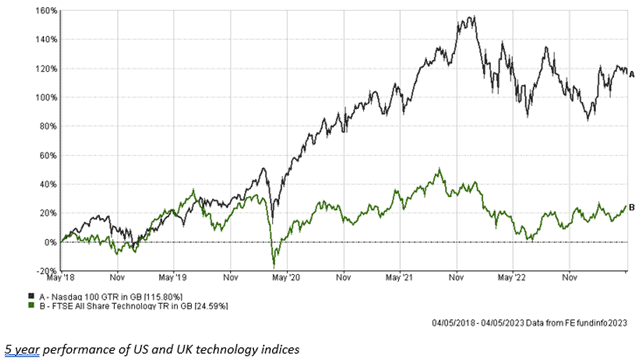
Emerging Markets
With the US dollars’ strength waning, Chinese economic activity picking up and emerging market (EM) rate hikes coming to an end, EM equities are looking more attractive relative to developed market (DM) equities for the rest of the year.
That being said, there is much variance among individual emerging countries and equity performance will not be consistent, see below. This is also true for individual companies in each region.
The Indian market has not posted positive returns this year. Outperformance over the past decade had led to investors rethinking valuations amid higher interest rates. Long-term, there is still huge potential for the Indian economy. With the population overtaking that of China, long-term investment in infrastructure and a growing middle-class sector are big tailwinds for economic growth and will help most areas to thrive.
While most countries have increased their interest rates this year and are expected to continue to do so, EM countries started their rate hikes a year earlier than developed countries. Countries such as India and Brazil have already paused hiking rates. The expectations here are for EM interest rates to drop sooner in order to boost economic growth.
Many EM interest rates are in double digits and the expectation is for interest rates to fall by larger magnitudes than we expect from DMs. Around this point, good returns would usually be expected from bonds. However, a higher inflation rate and longer term premium may restrict the returns from this sector from being as high as they would have been in the past.
This is good for equity markets both in terms of increased demand and increasing equity valuations due to lower interest rates.
Usually when DMs increase their interest rates this has the effect of reducing economic growth in EMs. This is because many EMs are exporting countries which rely on DMs to purchase their goods and services. When interest rates rise this demand drops which lowers the exporters’ GDP growth.
However in this case economic growth in EMs has remained strong. Much focus will be on US GDP growth. If this declines and rates move much higher then we expect to see declining EM performance. Any strengthening of the US Dollar will also add pressure. Lots of EM debt is denominated in US Dollars. When the US Dollar strengthens, this makes the interest payments on this debt more expensive.
If credit conditions tighten further and the US Dollar strengthens, we may see higher default rates on EM loans which will impact equity market performance.
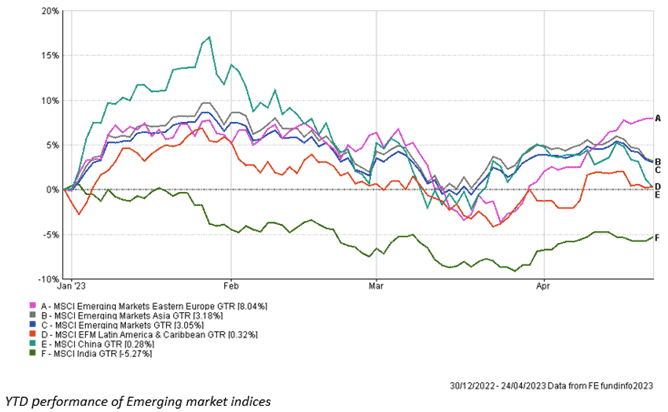
Emerging market equities got off to a good start this year and then returns started to dip as investors took profits amid weaker commodity prices. Many EMs are commodity exporters and so falling prices tend to hurt.
Usually falling prices spark increased demand, but for many commodities the demand is present at even high prices. Lithium for example is a much demanded commodity and when prices were high, demand did not dip. The reopening of China has relaxed some strain on the commodity sector and helped bring these prices down. On the other hand, China is a big importer of commodities and the reopening of the economy has helped to increase imports from other countries.
Last year EM equities underperformed their DM counterparts due to tighter credit conditions and higher risk levels. When volatility is higher and interest rates are rising investors move capital into safer havens. This could be from EM to DM equity or into cash and short-term bonds.
The recent banking issues have not had a significant impact on EMs. EM banks have strong balance sheets through regulatory requirements, some even stronger than that of US regional banks.
Long-term potential in the EM banking sector looks promising. EM banks are trading at big discounts compared to both their past valuations and UK and European banks. Profitability and returns on equity for the sector are strong, many higher than DM bank ratios.
The EM sector is diverse and awash with investment opportunities, most of them long-term. We are seeing an increase in technology usage, a growing middle class and a shift in income and wealth and all of this points to strong long-term growth.
A big risk to EMs is the reshoring of capital and resources domestically. The war in Ukraine has made DM countries rush to onshore energy opportunities. Whether this spreads to other goods is a risk. While it will not be possible to reshore all import needs, a reduction will impact EM economic growth.
While the IMF predicts average economic growth of 4.0% for EM countries in 2023 and 4.3% in 2024, higher than that predicted from DMs, economic growth does not necessarily mean equity markets returns will follow. The key theme at the start of the year was a bottom up selection of individual stocks and for EM this is no exception.
Europe
Following a similar increase from the US Federal Reserve, the European Central Bank hiked interest rates by 0.25% at the start of May, bringing the base rate up to 3.25%. While this marked a reduction compared with recent rate hikes, the head of the ECB, Christine Lagarde, warned that the battle against inflation was not yet won.
Many investors are expecting two more 0.25% increases by the ECB this year, with interest rates expected to peak at 3.75%. This is a lower rate than expected in the UK and the US but the economic dynamics are different in the Eurozone – the labour market is not as tight and unemployment not as low.
Data showed that the eurozone economy returned to growth in the first quarter of 2023, with an expansion of 0.1% quarter-on-quarter growth. The German economy witnessed zero growth in Q1 while other economies such as Spain and Italy saw an expansion. Eurozone inflation remains above the ECB’s 2% target, rising for the first time in six months to 7.0% in April. This was up from 6.9% in March.
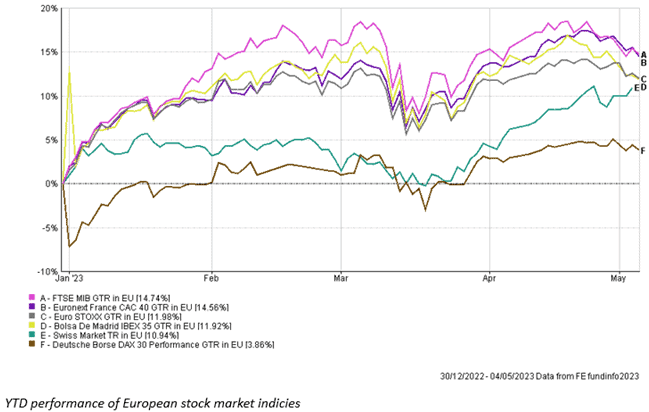
Improvements on the energy supply front have reduced the systematic risk to European equities, helping to account for the recent equity rally. With a YTD return of 10.39% from the MSCI Europe index, the region’s equities outpaced most other major markets. This strong Q1 performance was achieved despite a shock to the European banking sector when Credit Suisse was the subject of an emergency buyout by Swiss rival UBS.
Solid corporate earnings also boosted European share prices, with energy and real estate gaining the most. Europe’s technology sector fell short in April, after multiple warnings from semiconductor companies that a slowdown in demand is lasting longer than first anticipated.
While semiconductors were in large demand last year and supply could not keep up, with firms now cutting back production we are seeing a reversal in this trend. This should help to bring prices down.
How European equities perform in over the next few months will largely depend on the ECB’s response to inflation. If the ECB is forced to raise interest rates above 3.75% this year, equities may suffer in the short term as these rate increases are beyond current expectations.
Although most European banks look to be in good shape, with robust capital levels and high liquidity ratios, further interest rate hikes could be painful for the European banking sector. These increases will cause further losses on their large government bond holdings.
The European bond sector was mainly driven by inflation and central bank policies until mid-March. The focus then shifted to a potential banking sector crisis after the collapse of SVB and the sale of Credit Suisse.
These events forced investors to seek lower risk assets such as German bunds, pushing European yields lower. Yields on 2-year German government Bunds are currently around 2.555%, down from a high of 3.338% in mid-March. The yields on longer duration 10-year German government Bunds sit around 2.269%, down 7.5% year-to-date.
During recent weeks, hedge funds have been rushing to unwind their short positions against Italian government bonds as this highly indebted country delivers stronger than expected growth. A mild winter and a sharp drop in natural gas prices has given an extra boost to the economy, which is expected to grow by 1.2% this year, outpacing the ECB’s 1% growth forecast for the Eurozone. Italy’s 10 year government bond yield is currently 4.186%, down 8.3% year-to-date.
Japan
Japan left its monthly economic assessment unchanged for April, stating that the economy is “picking up moderately”, reflecting sturdy domestic consumption. Weakening foreign demand, however, fuelled by months of global interest rate hikes, is dimming Japan’s economic outlook.
Japanese consumer sentiment is improving due to the waning impact of the COVID-19 pandemic and rising wages, despite inflation accelerating at the fastest pace in recent history. The outcome of Japan’s recent annual wage negotiations between labour unions are expected to be the most productive in over 30 years. Historically Japan has been plagued by deflation (whereby prices fall rather than rise) which has resulted in minimal wage increases and low consumer demand.
Whilst domestic demand remains high, concerns around Japan’s exports were outlined in Japan’s monthly economic report – a worrying sign for an economy heavily reliant on exports. This assessment was made despite a recovery in demand from China and a boom from tourism, which is counted as an export in Japan’s trade data.
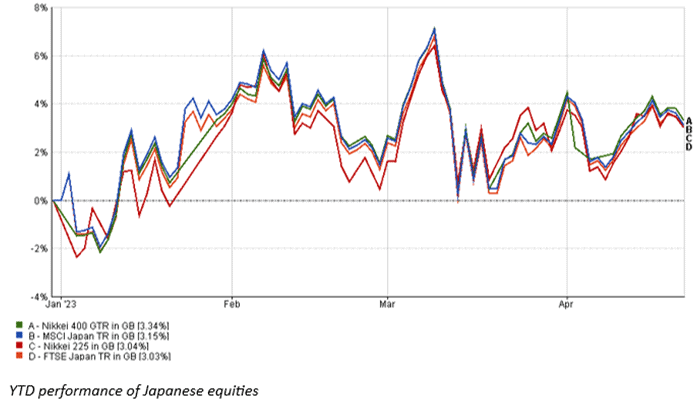
The chart above outlines the year-to-date performance of some of the major Japanese indices. All the indices started the year in negative territory but have since recovered to show returns of around 3%.
Investor sentiment is somewhat mixed towards Japanese equities. A recent visit to Tokyo by Warren Buffet suggested that he was interested in expanding his Japanese equities.
Some investors remain wary, however. Although Japan’s Tokyo Stock Price Index (TOPIX) has outpaced rivals in Europe over the past decade, it has lagged Wall Street. And for foreign investors who don’t hedge their exposure to currency fluctuations, a falling yen has damaged any significant investment gains.
Like most developed economies, Japan is experiencing some inflation, with a March inflation figure of 3.2%. Unlike other developed economies, however, Japan’s interest rate remains below zero, at
-0.1%.
The combination of a new Bank of Japan governor and rising prices is driving speculation that Japan’s days of ultra-loose monetary conditions may be coming to an end and that the country’s two-decade fight against deflation may finally be over. That should be good news for equities, which typically struggle in an environment of falling prices across the economy.
The risk present in Japan is that interest rate increases push inflation back down and back to the old pattern of deflation.
Unlike other major economies, Japan needs inflation in its economy. With base rates already in negative territory they cannot be lowered any further – this would eliminate any returns on government bonds and push capital out of the country.
Until inflation is sustainably at around 2.0% and wage growth is strong, the Central Bank will not raise interest rates or relax its yield curve control. This could potentially happen later this year or early next.
One of the major downsides to a negative interest rate policy has been a depreciation in the Yen compared with other currencies. This has made exports more competitive but imports more expensive, ultimately limiting economic growth if left unmanaged for too long.
Presently investors are building up holdings in short-dated Japanese bonds in the hope that interest rates begin to rise.
In order to see long-term potential in Japanese equities, many argue that a change in corporate structure is needed, with the breaking up of large conglomerates controlling multiple industries and traditionally low (or no) dividends being paid to shareholders.
US
The tech-heavy NASDAQ’s fast start to 2023 slowed compared with the more diversified S&P 500 and the Dow Jones in the last month. Each index gained 1.62%, 4.25%, and 5.52%, respectively.
The NASDAQ is still up a remarkable 19% since the start of the year with the S&P 500 also giving very respectable gains of 6.18%. The Dow Jones Industrial lags, up only 0.40% since the start of the year.
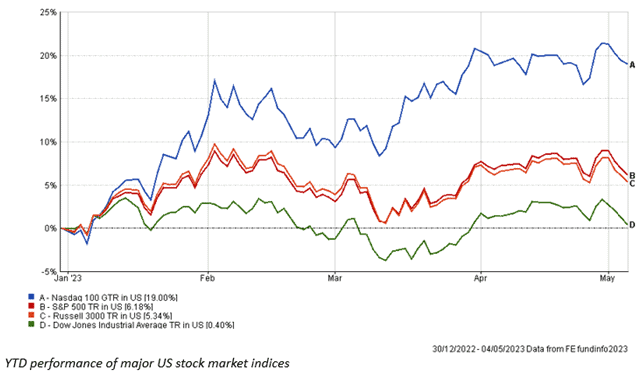
Part of the reason for the outperformance of tech has been because of base effects, with technology companies being the largest losers in 2022. Investor sentiment around technology companies has also improved as companies tighten their proverbial belts in the form of cost and job cuts. This will likely continue long-term as we see the rapid adoption of automation and even artificial intelligence, reducing the need for excess employees.
Interest rates remain at the forefront of investors’ minds as the fastest rate hike program in US history seems to be coming to an end. The federal funds rate, which acts as a benchmark for US and global investors, currently sits between 5% to 5.25%, after the Federal Reserve’s May meeting.
Most market participants expect this to be the peak in rates, with slight rate cuts by the end of the year. As Fed Chairman Jay Powell insists on the “higher for longer” narrative, his moves will ultimately be dictated by developments in the Fed’s dual mandate of 2% inflation and maximum employment.
Some investors believe that higher interest rates are here to stay with cuts only being necessary in a recessionary or crisis environment. More likely, in our view, the Fed will keep rates higher and use a recession as a way of bringing inflation down, potentially not cutting rates until much later into 2024.
Since our last commentary, March inflation data for the US shows that CPI rose 0.1% over the last month and 5.0% over the last 12 months, continuing the downtrend. Core CPI, the Fed’s preferred measure as it excludes the volatile food and energy, rose 0.4% in March and 5.6% over the last 12 months.
Shelter was the biggest contributor to the increase, more than offsetting the decline in energy. The CPI report for April will be published on May 10th, with economists predicting a continuation of the downtrend to around 3% by midsummer. Although this is still above the Fed’s target, it will be seen as a positive by investors as inflation may not be as sticky as once thought.
The April US jobs report was also released since the last commentary. It showed a gain of 253,00 total nonfarm payroll employment and unemployment little changed at 3.4%. Unemployment is at the same level as pre-pandemic and under the Federal Reserve’s maximum employment target, which is estimated to be around 4%.
The biggest contributor to the job gain was professional and business service, which added 43,000 jobs. Strong labour numbers boost investor confidence that the underlying economy is much healthier than sentiment may suggest. US Gross Domestic Product rose at a 1.1% annualized pace in Q1 2023, well below the 2% estimates.
The US debt ceiling has again been making the headlines in Congress, but investors can rest assured that, as always, it will be raised so that accommodative fiscal policy can be resumed. The US debt currently sits up against the stated debt ceiling of $31.4 trillion. Borrowing is crucial for the US to continue to run deficits and grow its economy every year.
The US bond “yield curve” remains inverted with the 2-year treasury note yielding 4.06% and the 10-year treasury note yielding 3.52%.
In normal market conditions, bond yields are positively correlated with duration as longer duration is considered riskier. The inversion of the yield curve is a widely used recession predictor as investors see the immediate future holding more risk than the long term.
Although the US has not officially entered a recession yet, the reversion of the yield curve towards its normal pattern typically signals an economic recovery as investors look past the recession. The 2-year and 10-year spread has narrowed by around 1.01% since the March spike in yields. Some market commentators are therefore touting a “soft landing” or even no-landing scenario for the US economy, meaning it may avoid recession entirely.
Although there has not been a lot of difference in government vs corporate bond performance, lowering inflation expectations may push yields lower. Any signs of a recessionary environment will push investors away from lower credit quality bonds and into higher quality government bonds.
Talks of de-dollarization have become popular again as BRICS nations (Brazil, Russia, India, China, and South Africa) join allegiance with rumours of non-dollar trading. Although it cannot be guaranteed that the dollar will be the global reserve currency in 100 years, it is safe to assume that the dollar will remain king for the foreseeable future.
This assumption is based on the dollar making up 58.36% of global foreign exchange reserves according to the IMF and at this point, there is no viable alternative. The dollar index, as measured against a basket of global currencies, currently trades at 101.42, down from the post-pandemic high of 111.95 and 104.52, from the start of the year.
If the dollar continues to experience short-term weakness, dollar-denominated asset prices will continue to rise nominally. Interest rate expectations also have a strong influence on the value of a currency. If investors expect interest rates to decrease, the value of the currency will too as they move funds into higher yielding assets.
After the struggles in the banking sector in March with the failures of Silicon Valley Bank and Credit Suisse, banks have steadied.
As measured by the Dow Jones U.S. banking index, banks experienced a 21.33% decline but are now up 7.91% from the lows. This can be attributed to the feeling that the banking crisis is not severe as once imagined and strong earnings from big US banks. JP Morgan Chase, the largest of the US banks, posted record revenue in Q1 2023 as they were able to profit from high interest rates and large deposit inflows from smaller, regional banks.
On the topic of profits, blue chip companies, such as Coca-Cola and McDonald’s, posted strong earnings. Both cite strong demand despite price hikes. As more US companies report over the following weeks, investors will have a better picture of the strength of the consumer given the challenging environment.
As mentioned earlier, technology has been the strongest performing sector so far this year, followed by consumer discretionary, returning 24.18% and 12.39% respectively. Consumer staples are up slightly with a return of 3.82%. Energy and banks are performing the worst at -9.72% and -16.10%, respectively, as the following chart shows.
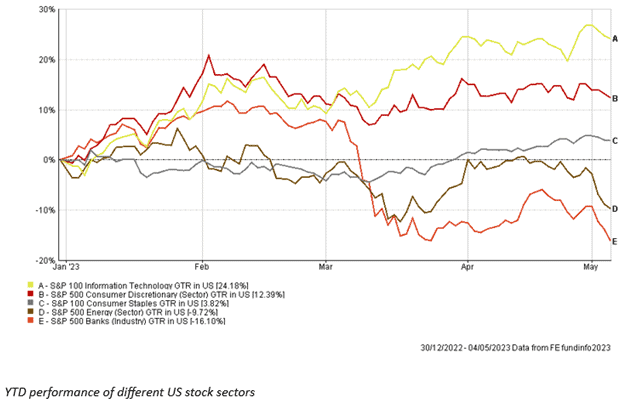
China
China’s economy got off to a solid start in 2023, with Gross domestic product (GDP) growing by 4.5% in the first quarter from a year ago, according to the National Bureau of Statistics. This growth rate was higher than forecast by analysts and beat the estimate of 4% growth from a Reuters poll of economists.
China’s consumer economy showed signs of resurgence, with retail sales rising 10.6% in March, representing the biggest jump in almost two years and more than double the forecast rate. During the same month, industrial production also rose 3.9% compared with a year earlier (a five-month high).
China’s exports unexpectedly surged in March, but analysts cautioned the improvement partly reflects suppliers catching up with unfulfilled orders after the COVID-19 disruptions.
China’s economy is accelerating after pandemic restrictions and trade restrictions with the US which slowed growth. For almost three years the Chinese government persisted with rolling lockdowns and mass testing to stop Covid-19 from spreading. In 2022, China’s GDP expanded at its slowest pace since the mid-1970s, other than for the Covid-hit 2020 year. After widespread protests in November, health authorities abruptly ended most quarantine requirements and reopened borders for international travellers.
However, there are still challenges to the outlook for China’s economy, including global risks such as a global economic slowdown and debt risks. More than a year-long sweeping streak of global monetary policy tightening to rein in inflation has dented world economic growth, leaving many countries including China reliant on domestic demand to spur momentum and raising the challenge for policymakers looking for post-COVID stability.
Chinese policymakers have pledged to step up support for the $18 trillion economy to keep a lid on unemployment, but they face limited room to manoeuvre as businesses grapple with debt risks, structural woes, and global recession worries.
China’s rebound has so far remained uneven as its investment-fuelled growth of the past changes to become more reliant on consumption. Consumption, services, and infrastructure spending have perked up, but factory output has lagged amid weak global growth. Slowing prices and surging bank savings are raising doubts about demand.
Over the last month, the Hang Seng index is down -1.45% and the Shanghai Composite is down -0.02%. YTD the Hang Seng is down -1.74%, whilst the Shanghai Composite is up 3.03%. This underperformance can be attributed to worries from foreign investors because of rising geopolitical tensions.
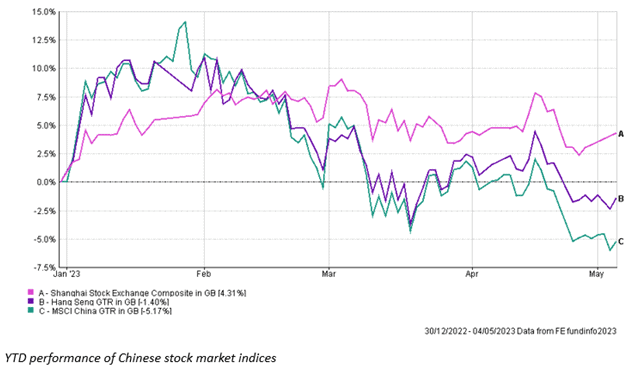
The Chinese bond yield curve looks a lot healthier than that of the US, although they have lost their yield advantage in the last year. The 2-year yield currently sits at 2.389% and the 10-year yield at 2.817%, very much unchanged from the start of the year. The Chinese bond market brings about different risks compared to, the larger, US bond market. These being less liquidity and the local currency value.
Overall, China’s economy is showing strong signs of recovery and growth in the first quarter of 2023. However, there are still challenges and uncertainties that could impact its future growth. The country’s strong performance in terms of GDP growth and consumer spending is encouraging, but there are still risks such as global economic slowdown, political turmoil, and debt risks.
Unfortunately, the political backdrop is always a factor that needs careful consideration when investing in China. With the war in Ukraine and Taiwan raising tensions the immediate future remains uncertain, but there may be opportunities here over the medium to long term.
Robert Dougherty, Associate IFA
Ryan Carmedy, Graduate Trainee IFA
Harry Downing, Graduate Trainee IFA
May 2023
This article is not a recommendation to invest and should not be construed as advice. The value of an
investment can go down as well as up, and you may get less back than you invested.